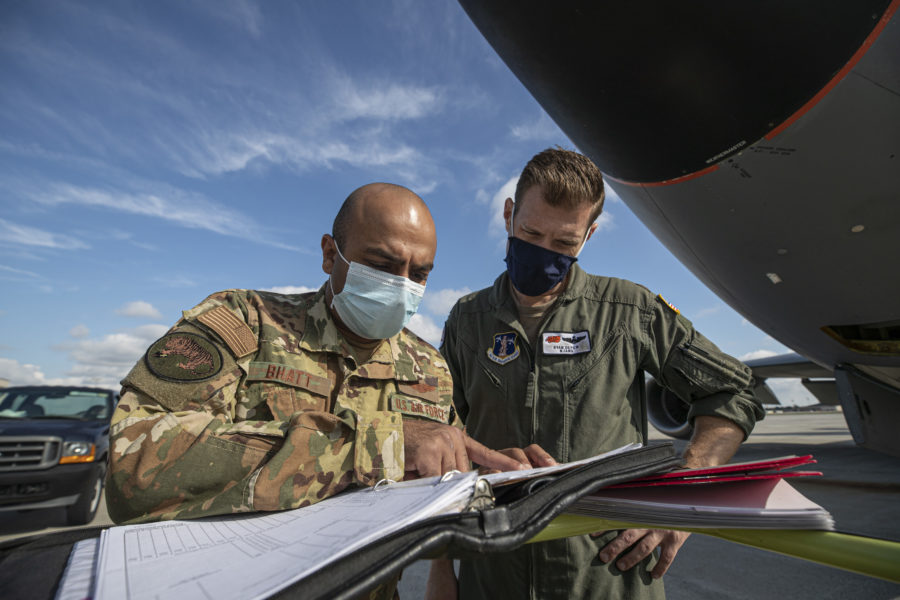Employing artificial intelligence to help identify targets in a simulated fight, “and then turning that into a solution”—whether it’s kinetic or non-kinetic—has reportedly shortened the decision-making from what might have taken as long as five hours to just one hour while also improving accuracy.
Army Col. Joe O’Callaghan, 18th Airborne Corps fire support coordinator and artificial intelligence-enabled targeting lead, summarized some of his service’s discoveries during an online event presented by Defense One and NextGov on Oct. 28. His remarks recapped aspects of the Army-led Scarlet Dragon bombing exercise this month that relied on satellite images and which included “heavy investment” by the Air Force.
As the Army’s “global response force,” O’Callaghan said the 18th Airborne started investigating AI applications during “a lengthy dialog on … the necessity to evolve our capability to conduct warfare.” The evolution comes as the corps transitions from a counterinsurgency focus to preparing for possible large-scale combat operations, “which really is back in the news again for us,” O’Callaghan said.
A-10s from the Air Force’s 75th Fighter Squadron took part in Scarlet Dragon along with the 53rd Wing and 461st Air Control Wing, as did the 108th Wing of the New Jersey Air National Guard. Queries to Air Combat Command and the 18th Airborne about further participation by the Department of the Air Force weren’t immediately answered.
For a sense of how AI has affected the speed and precision of targeting, O’Callaghan cited a recent test in which AI algorithms narrowed down initial sets of data that were then vetted by human analysts. “When we took the AI and tipped the human where to look, we were exceeding 95 percent in our capabilities to identify what to look for,” he said. That was better than both the 44 percent precision of AI on its own and the approximately 85 percent precision of just humans, but accuracy wasn’t the only gain.
“Instead of being [in excess] of 320 minutes, we were actually doing this in right around one hour. So you’re talking a difference between five hours versus one—and that was preferring itself into immediate tactical decisions that could be made,” O’Callaghan said. “And this really is the crux of targeting. AI is now enabling us not only to conduct more targeting, but to conduct it quicker and then begin to quickly merge intelligence and operations together.”
With AI first culling the available intelligence information, “an analyst is no longer looking at 700 square kilometers of geospatial information,” O’Callaghan said. “He’s actually having that presented to him. And then he’s rapidly checking what the computer has provided and then moving that into a decision process that is going to result in an effect being delivered against it.”
The Department of the Air Force has reportedly started to deploy AI algorithms in targeting as well. Secretary Frank Kendall announced in August that the Chief Architect’s Office had “deployed AI algorithms for the first time to a live operational kill chain … for automated target recognition.” He said the event represented “moving from experimentation to real military capability.”
Looking ahead to the broader adoption of AI, O’Callaghan paraphrased an idea he found “fascinating” that he heard put forth by Eric Schmidt, the former Google CEO who chaired the National Security Commission on Artificial Intelligence:
“Use government for what government does best—that’d be targeting. Those are the cases that haven’t been monetized in the industry,” O’Callaghan said. “And use commercial for what commercial does best. They’ve already got the developers—the engineers.”
O’Callaghan said DOD’s Project Maven, which uses machine learning to identify people and objects in intelligence imagery, “formed a real critical linchpin of all of this … a way for us to really institutionalize this and continue to evolve it.”
The national AI commission’s work ended following the publication of its 756-page final report, but Schmidt, now an investor in the AI startup Rebellion Defense, has committed a share of his personal fortune to continuing the commission’s work.
Editor’s Note: This story was updated Oct. 29 at 7:08 p.m. Eastern time to include information from Air Combat Command about units that took part in Scarlet Dragon. F-15s from the 4th Fighter Wing “did not end up participating in the end due to mission requirements,” according to a spokesperson.

